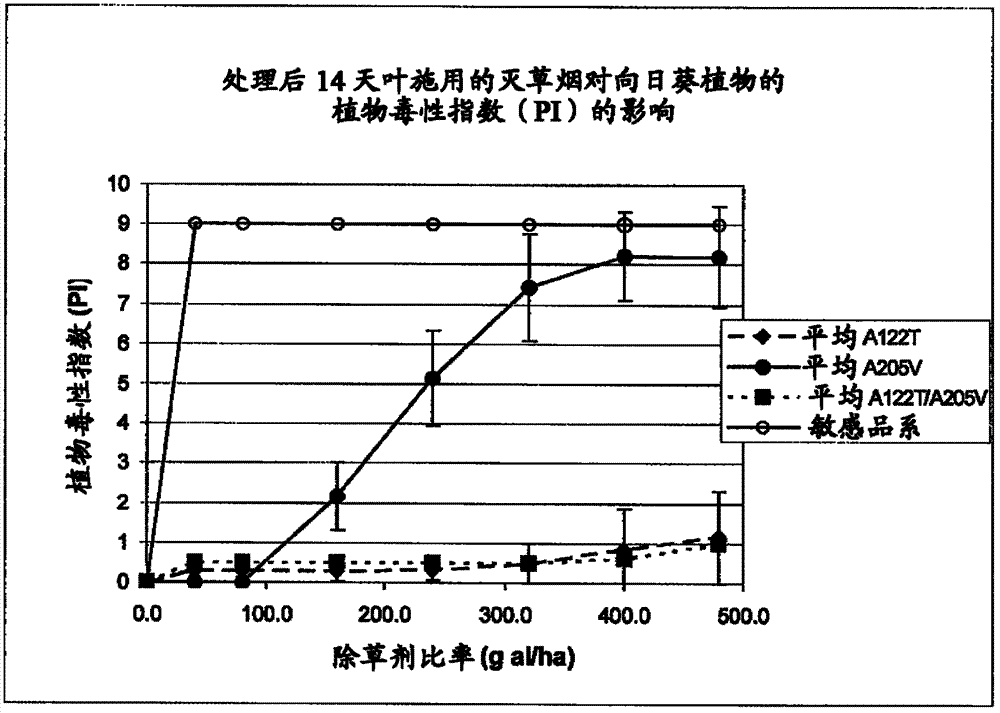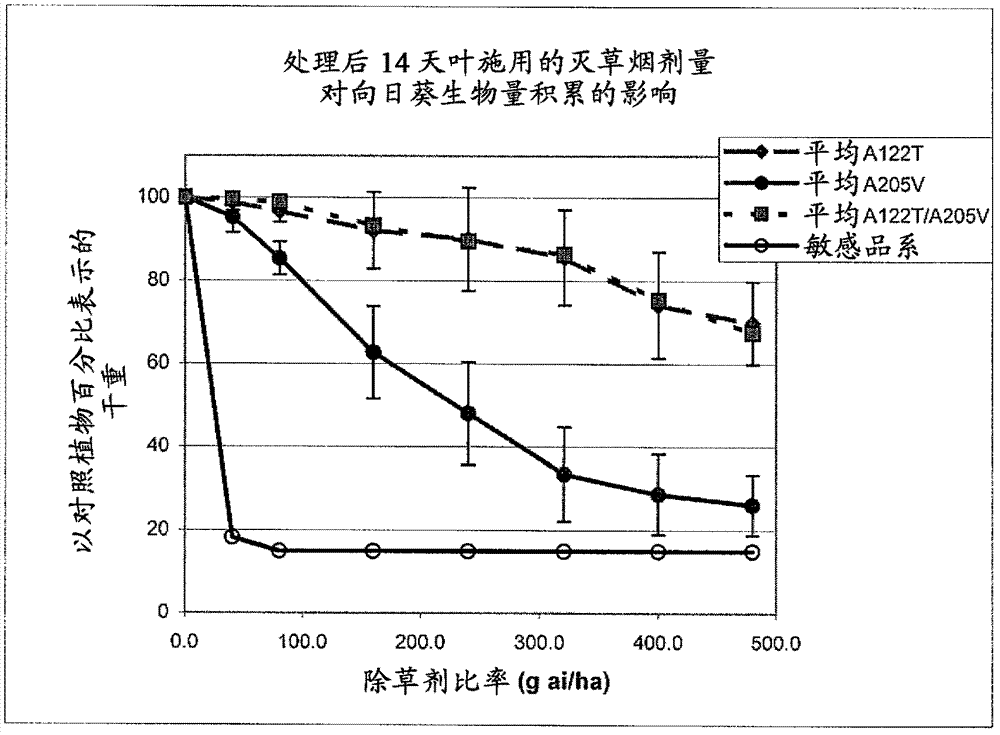Herbicide-resistant sunflower plants with multiple herbicide resistant alleles of AHASL1 and methods of use
A sunflower and genetic technology, applied in the field of agriculture, can solve the problems of undescribed imidazolinone-specific resistance and other problems
- Summary
- Abstract
- Description
- Claims
- Application Information
AI Technical Summary
Problems solved by technology
Method used
Image
Examples
Embodiment 1
[0191] Example 1: Phenotypic interactions of imidazolinone resistance mutations in sunflower AHASL1
[0192] GM40 and GM1606 are mutant derived lines of sunflower that show a high level of tolerance to imidazolinones due to a point mutation at codon 122 of AHASL1 (Arabidopsis nomenclature) (WO2007005581 and Jul. 1, 2005 filed U.S. Provisional Patent Application Serial No. 60 / 695952). This demonstrates that the A122T mutation and derivative lines and hybrids homozygous for this mutation show better tolerance to imazamox than the known commercially available Clearfield sunflower homozygous for the A205V mutation on AHASL1 (WO2007005581) . Both mutants exhibit an incompletely dominant, sensitive allele relative to the wild type, as do many other examples in the literature. The present invention is based on the discovery that the A122T mutation exhibits near complete dominance over A205V for resistance to imidazolinones over the herbicide application range of 0.5X to 6X commerci...
Embodiment 2
[0196] Example 2: Response of homozygous A122T / A122T and A205V / A205V and heterozygous A122T / A205V events to imazapyr at the whole plant level
[0197] This experiment was performed to quantify and compare imazapyr in sunflower hybrids carrying the A122T and A205V mutations in homozygous (A122T / A122T or A205V / A205V) and heterozygous (A122T / A205V) states on different genetic backgrounds and at the whole plant level sensitivity.
[0198] Material
[0199] Seeds of different sunflower lines (Table 1) were obtained under field conditions.
[0200] Table 1. Sunflower materials utilized, their families, and types of mutation events.
[0201] the code family lineage Line (L) or Hybrid (H) mutation event L1 L A205V L2 L A205V H1 L1x L2 H A205V L3 cmsGM40 L A122T L4 L A122T H2 L3x L4 H A122T L5 BTK 47 L Sensitive H3 L3x L2 H A205V+A122T H4 L1x L4 H A...
Embodiment 3
[0236] Example 3: Herbicide tolerance of A122T and A205V homozygous and heterozygous lines and two mutant heterozygous lines (A122T / A205V) under field conditions
[0237] This experiment was carried out under field conditions to compare the difference between the mutants carrying the A122T and A205V mutations in homozygous (A122T / A122T or A205V / A205V), heterozygous (A122T / - or A205V / -) and double stacked heterozygous (A122T / A205V) states. Herbicide tolerance of genotyped sunflower hybrids and lines.
[0238] Material
[0239] The sunflower materials used are listed in Table 5.
[0240] Table 5: Item List
[0241]
[0242]
[0243] method
[0244] Seeds for each item in Table 5 were produced during the 2005-2006 growing season under optimal seed production conditions in South America. Field trials were conducted in 2006 at a site in North Dakota, USA. These items were arranged in randomized complete blocks using a split-plot design consisting of 3 replicates per ...
PUM
 Login to View More
Login to View More Abstract
Description
Claims
Application Information
 Login to View More
Login to View More - R&D
- Intellectual Property
- Life Sciences
- Materials
- Tech Scout
- Unparalleled Data Quality
- Higher Quality Content
- 60% Fewer Hallucinations
Browse by: Latest US Patents, China's latest patents, Technical Efficacy Thesaurus, Application Domain, Technology Topic, Popular Technical Reports.
© 2025 PatSnap. All rights reserved.Legal|Privacy policy|Modern Slavery Act Transparency Statement|Sitemap|About US| Contact US: help@patsnap.com



